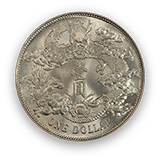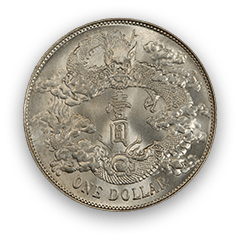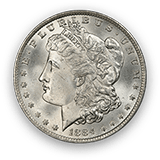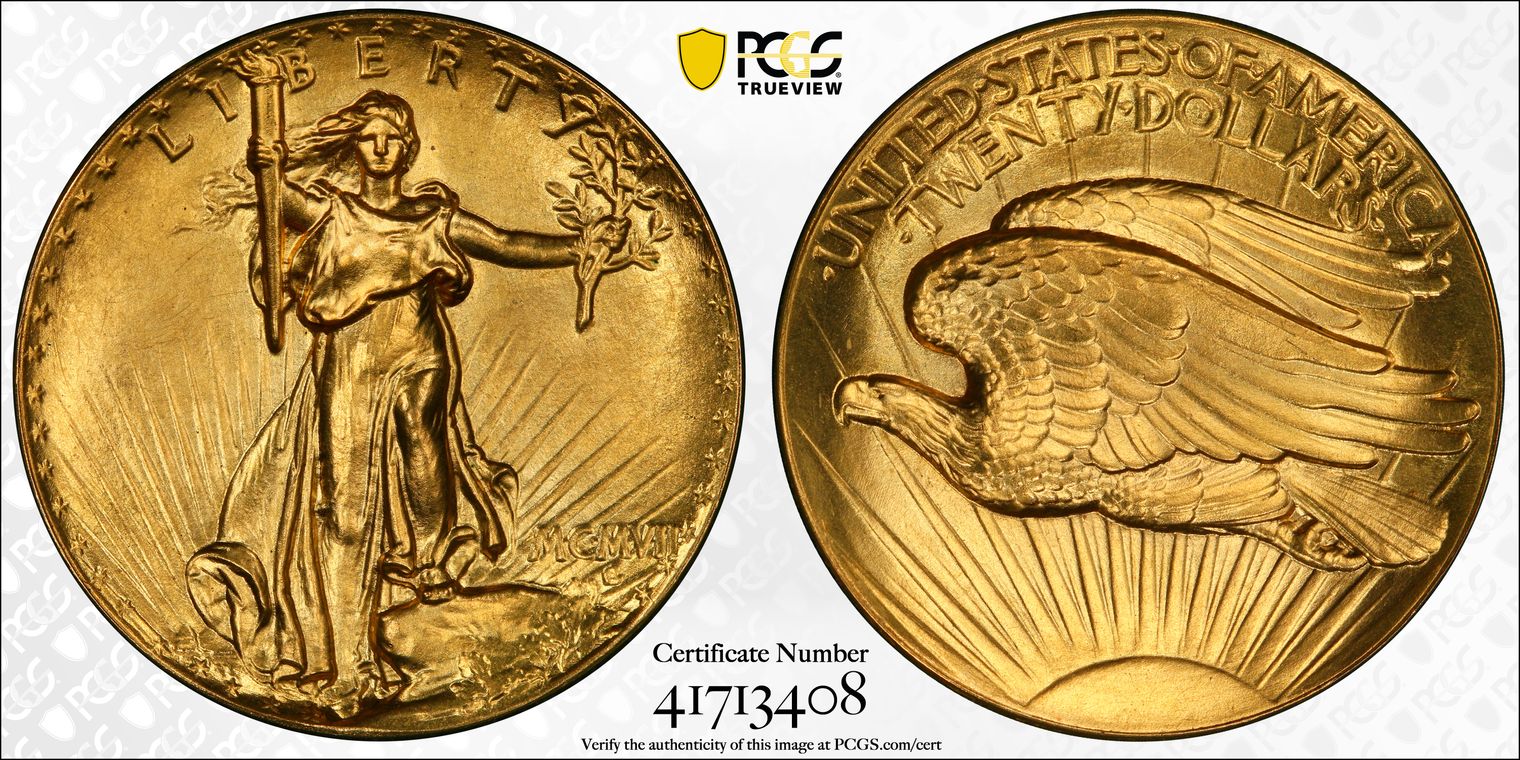1907 $20 Extremely High Relief Inverted Edge Letters PR68 认证号41713408, PCGS号9132
专家评论
Ron Guth
According to Burdette (2006), The Ultra-High Relief Double Eagles (also known as Extremely High Relief) were struck in three batches:
Group 1, February 7-14, 1907 – 3 complete coins, 1 plain edge from cracked die. Coins from the first group were struck using the same edge collar as the 1906 $20 gold pattern (J-1773). This edge bore sans-serif letters configured as E*P*L*U*R*I*B*U*S*U*N*U*M*. All known examples were struck so that the edge reads normally when the obverse faces up. The plain edge piece is incomplete, as the die broke before the final step of adding the edge lettering was possible. Coins from the second and third groups wers struck with a new reverse die and an edge collar configured as E*PLURIBUS*UNUM***********. The letters on this edge bear serifs, unlike the previous version. Coins from the second group read with the reverse up; coins from the third group read with the obverse up (known as "inverted edge lettering).
Group 2, March to July, 1907 – 12 (or more) complete coins.
Group 3, December 31, 1907 – 3 complete coins.
The 1907 Ultra-High Relief Double Eagle is actually a Pattern issue, struck to test the design concepts of Augustus Saint-Gaudens. Mint officials were fully aware of the impracticality of the design and the technical difficulties inherent in its production, but they were under pressure from the President, Theodore Roosevelt, to produce a tangible version of Saint-Gaudens classic design. The result is one of the rarest and most valuable of all American coins.
The importance and popularity of the 1907 Ultra-High Relief is undisputed. In the recently published book “100 Greatest U.S. Coins” (by Jeff Garrett and Ron Guth), the Ultra-High Relief was voted fifth best by the members of the prestigious Professional Numismatists Guild, placing it among such aristocratic company as the 1804 Silver Dollar, the 1913 Liberty Nickel, and the unique 1849 Double Eagle.
Time-line of the Ultra-High Relief $20 Gold Piece:
1901 - President Theodore Roosevelt and the artist Augustus Saint-Gaudens meet at the Pan-American Exposition and begin a correspondence.
1905 (November 6) - Saint-Gaudens writes to President Roosevelt: “…I was looking at some gold coins of Alexander the Great today, and I was struck by their high relief. Would not it be well to have our coins in high relief, and also to have the rim raised?…”
1906 (January 9) - Saint-Gaudens writes to President Roosevelt: “Whatever I produce cannot be worse than the inanities now displayed on our coins.”
1906 (First Quarter) - Saint-Gaudens’ health deteriorates (cancer) and he turns over the completion of the Ultra-High Relief models to his assistant, Henry Hering.
1906 (December 20) - President Roosevelt writes to Saint-Gaudens, praising him on the models and instructs the Director of the Mint to create the dies as quickly as possible.
1907 (February) - the first Ultra-High Reliefs are struck.
1907 (July) - George E. Roberts resigns as Director of the Mint
1907 (August 3) - Saint-Gaudens dies.
1907 (September) - Frank A. Leach becomes the Director of the Mint.
The Words of the Director of the Mint, Frank Leach
From "RECOLLECTIONS OF A NEWSPAPER MAN – A Record of Life and Events in California" by Frank A. Leach, published in 1917
“Another very important matter was in hand in the bureau when I arrived at Washington, which was soon to cause me some anxiety, and that was the perfection of President Roosevelt’s scheme for new designs for all the gold coins of our country. There were a number prominent people in the East, especially in New York and Boston, who some time before began an agitation for an improvement in appearance of all our coinage. The President quickly became the leading spirit of the movement. The prevalent idea in this undertaking was that the design and execution of our coinage were inferior and inartistic when compared with those of ancient Greece; and as the coins used by a nation are one of the most enduring records of the art and mechanical skills of its age, our government should make an issue of coinage that would leave to future generations and ages something that would more truthfully and correctly reflect the artistic taste and mechanical ability of our day than the coinage then in use, unchanged for so many years. The admiration for the ancient Greek coins unwittingly influenced those gentlemen to suggestions that were imitative rather than original. They wanted the designs for the proposed coinage to be brought out in high relief, or with medallic effect, like the designs on the ancient coins. The commercial use and requirements seemed to have been lost sight of in the enthusiasm of producing a highly artistic coin; but in all probability none of the leading spirits in the movement was familiar with the use of metallic money, and did not understand that the proposed high relief would make the face of the coins so uneven that the pieces would not “stack,” which was a condition fatal to the practicability of the idea.
It was early in the year 1905 that President Roosevelt authorized the Director of the Mint to conclude a contract with the famous sculptor, Saint-Gaudens, to supply designs in high relief for the $20 and $10 gold coins. This was accomplished in July, but no designs were finally perfected that met the approval of the President until the early part of 1907. The first model was a design for the double eagle, or $20 piece. Dies from the model were made at the Philadelphia mint. On trial, the dies gave such a high relief to the figures on the design that all efforts to produce a perfect or satisfactory coin on the regular coining presses were ineffectual. A medal press was then resorted to, that the beauty of the design might be studied and preserved in the shape of a coin, but even by this process it required about twelve blows or impressions in the press for each piece, with an annealing process between each stroke of the process. The annealing process consists of heating the coin to a cherry-red heat and cooling it in a diluted solution of acid. This process eliminates the copper alloy on the surface of the coin and leaves the piece covered with a thin film of pure gold. As a work of art the pieces were beautiful, but had more the appearance of medals than coins for daily use. Nineteen pieces only from this model were struck on the medal press, and these were subsequently given to mint and Washington officials connected to the work.
There were some who thought that by reducing the diameter of the piece to about the size of a “checker,” with a corresponding increase in the thickness, the much desired high relief might be struck on the ordinary coin press; accordingly dies were made and several pieces struck, when it was discovered that the coinage act, passed in 1890, prohibited the change of the diameter of any coin. Thirteen pieces were struck from this small die for the thick or checker pieces, but with the exception of two coins placed in the cabinet or collection of coins at the Philadelphia mint, all of these pieces were melted and destroyed on account of the improper or illegal dimensions.
Saint-Gaudens then attempted to facilitate the work of coinage by supplying another or second set of models with the relief reduced to some extent, but satisfactory results were not obtained on the regular coinage presses. He then made a third model with still further and greater reduction of the high relief. The failure gave rise to considerable friction between the artist and the mint authorities. The President had become impatient and began to think that the mint officials were not showing a zeal in the work that promised results. It was at this stage of undertaking that I came into the office of Director. Before I had become familiar with my surroundings the President sent for me. In the interview that followed he told me what he wanted, and what the failures and his disappointments had been, and proceeded to advise me as to what I should do to accomplish the purpose determined upon in the way of new coinage. In this talk he suggested some details of action of a drastic character for my guidance, which he was positive were necessary to be adopted before success could be had. All this was delivered in usual vigorous way, emphasizing many points by hammering on the desk with his fist. This was my first interview with the President, and it was somewhat embarrassing for me to oppose his views, but I felt that it was essential to my success that I should be untrammeled by any interference in the plans that I should adopt to secure the production of the new coinage. I determined then and there that if I could not have free rein in the matter I would not attempt the work. In my reply to the President I finally made the wisdom of my position clear to him. I explained to him how I had not yet had time to look into the matter and locate the causes of failure, consequently could not say what was necessary to correct them. At any rate, I would have to insist that these were matters of details that should be left to my judgment.
“All you want, Mr. President,” I said, “is the production of the coin with the new design, is it not?”
“Yes,” said he.
“Well, that I promise you.”
He said he guessed I was right in my attitude in the matter, but I think he was not very confident of my getting results, for when a few days later I laid upon his desk a sample of beautifully executed double eagles, of the Saint-Gaudens design, he was most enthusiastic in his expressions of pleasure and satisfaction. I certainly believed him when he declared he was “delighted.” He warmly congratulated me on my success, and was most complimentary in his comments.
“Now,” he said, “I want enough of these coins within thirty days to make a distribution throughout the country, that the people may see what they are like.” I replied that we would be able to meet with his desire, although I explained that the issue would have to be struck on medal presses from the second design model, but that in a few weeks later, we would have dies completed from model No. 3 with lower relief, so that the coins, when made, would meet the requirements of the bankers and business men in “stacking,” etc., and these could be struck on the regular coin presses in the usual way. The pleasure of the President was manifested in the heartiness of his thanks. I had every medal press in the Philadelphia mint put into operation on these coins with an extra force of workmen, so that the presses were run day and night. The officers of the mint entered into the spirit of the work cut out for them, putting zest into the operations which assured me that the issue of the new double eagles, so greatly desired by the President, would be made on time. In fact, we delivered to the Treasurer of the United States 12,153 double eagles, representing $243,060, which was considerably more than asked of us, several days ahead of time. I came in for more compliments from the President. In his enthusiastic way he introduced me to several of his Cabinet officers who were present in his office, as a “man who got results.” The coins of this issue, when made available to the public, were much sought after by people who wanted to keep them as souvenirs or as additions to numismatic collections. Contrary to expectations, a premium was demanded by dealers soon after the distribution began, and by the time it was ended the premium has increased to about an average of fifteen dollars on a piece. The newspapers gave much space to criticism, both by their own editors and from correspondents. Opinions as to the merits of the new coin were fairly well divided. The artistic appearance of the coin was generally recognized, but it could scarcely claim a popular reception. The design of the eagle on the reverse side of the coin was the object of much adverse comment. Saint-Gaudens did not use any originality in the design of the eagle, but simply copied that used on the penny coined in 1857, following the feature of the bird flying with its talons extended backward under the tail feathers, instead of being drawn up under the breast, the position most generally observed in the birds of prey when flying about.
While discussing with the President the criticism by the public, I spoke of the position of the talons as being incorrect. This the president promptly denied, and said that if I would visit the large aviary at Rock Creek Park I would find the eagles flying about just as represented by the Saint-Gaudens design. I did not know then that the President was such a close observer of things in nature, and, having doubts as to the accuracy of his opinion, I went to the aviary as he had suggested. I did not have to wait to be convinced of the correctness of the President’s assertion, for the very first flight of an eagle across the aviary showed the talons extended out behind, in the manner of a crane of gull.
The greatest extent of unpleasant criticism over the new issue was aroused by the discovery that the motto, “In God we trust,” had been omitted from it. The President’s mail, as well as that of the Secretary of the Treasury, was flooded with letters, some mild and many bitter, in protest against the removal of the motto. So loud became this protest that the President felt called upon to defend the omission, in a statement to the press, wherein he took the position that it was a profane use of the name of God, and the motto had been very properly omitted. He could have made an explanation that would have silenced all criticism and relieved himself of the responsibility for the omission if he had referred his critics to coinage acts of the government.
The statutes of the United States supply the only words and mottoes that shall appear on the various coins authorized by the act of Congress. For many years the motto, “In God we trust,” was included with other word requirements by law. In 1890 the coinage act was changed in several particulars, and when the re-enactment was completed the motto in question, whether by design or accident, had been omitted. So when Saint-Gaudens was given the words and figures that must appear on the coins, the motto was not included. When this was understood an appeal was made to Congress, and that body quickly authorized the restoration of the words, “In God we trust.”
While the people were talking about the new coins, the mint officials were busy working on the dies from model number three, and their efforts to produce them on the ordinary coining presses were finally crowned with success, and by the latter part of December the mint presses were striking off new double eagles at the rate of about $1,000,000 daily. Excepting the addition of the motto, the design is the same as that used in the coining of $20 pieces at all the mints of the government ever since.
Sources and/or recommended reading:
“The Dr. Richard Ariagno Collection“, Ira & Larry Goldberg Coins & Collectibles, Inc., May 31-June 2, 1999
“The ‘Dallas Bank’ Collection”, Sotheby’s/Stack’s, October 29-30, 2001
“The Benson Collection, Part III,” Ira & Larry Goldberg Coins & Collectibles, Inc., February 24-25, 2003
“100 Greatest U.S. Coins” by Jeff Garrett and Ron Guth
“Walter Breen’s Complete Encyclopedia of U.S. and Colonial Coins” by Walter Breen
“Deciphering the mystery of the MCMVII extremely high relief double eagles" by Roger Burdette. http://uspatterns.com/mcmviehrdoub.html
稀有性和存量估计 了解更多
| 所有评级 | 2 |
| 60或以上 | 1 |
| 65或以上 | 1 |
| 所有评级 | R-9.9 |
| 60或以上 | R-10.0 |
| 65或以上 | R-10.0 |
| 所有评级 | 2 / 3 |
| 60或以上 | 1 / 3 TIE |
| 65或以上 | 1 / 3 TIE |
| 所有评级 | 4 / 14 TIE |
| 60或以上 | 1 / 14 TIE |
| 65或以上 | 1 / 14 TIE |
状况普查 了解更多
| #1 PR68 PCGS grade |
| #2 PR68 PCGS grade |




















